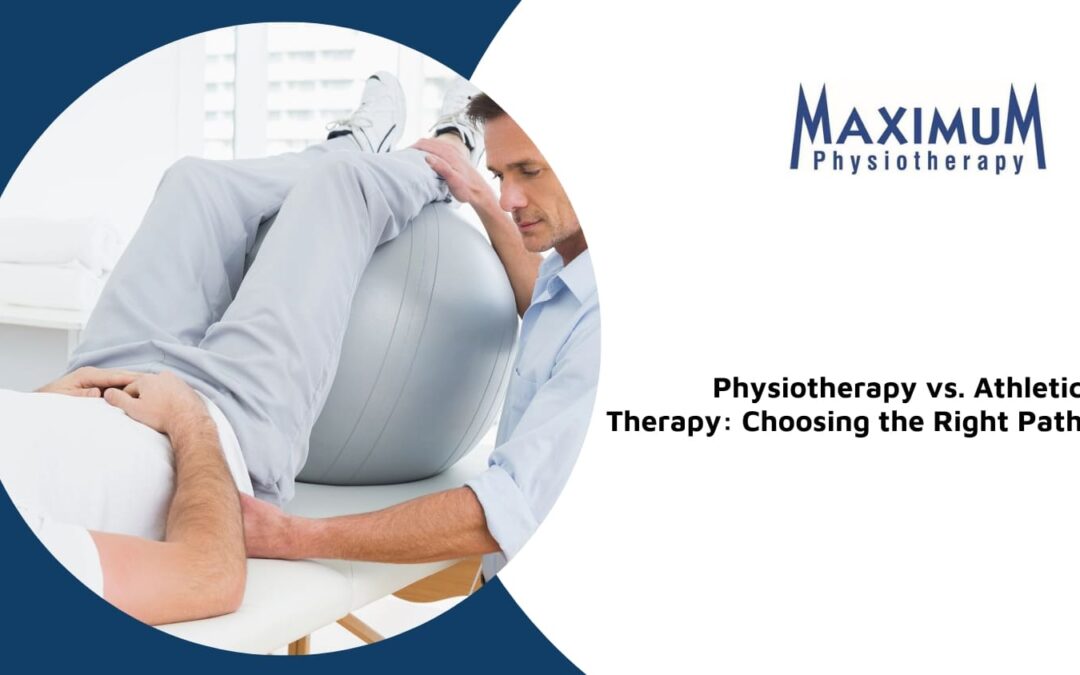
Physiotherapy vs. Athletic Therapy: Choosing the Right Path

Navigating the world of rehabilitative care can be complex, especially when deciding between physiotherapy and athletic therapy. Each discipline offers unique approaches to health and recovery, tailored to different needs and conditions. In this blog, we will explore the differences and similarities between these two therapies, helping you make informed decisions about which might be best for your specific situation. We’ll delve into their treatment philosophies, when and why you might choose one over the other, and how they can potentially be combined for optimal results.
Physiotherapy and Athletic Therapy: How Do Their Treatment Philosophies Differ?
Physiotherapy and athletic therapy share common goals of enhancing physical function and reducing discomfort, but their treatment philosophies diverge in focus and approach. Physiotherapy emphasizes a broader scope of care, addressing a wide range of physical issues through a holistic lens. In contrast, athletic therapy concentrates on active rehabilitation and performance improvement, often catering to sports-related injuries.
- Holistic Approach in Physiotherapy: Physiotherapy considers the entire body and its systems, applying treatments to improve overall function and mobility. This includes addressing issues arising from chronic conditions, surgeries, or general wear and tear.
- Focus on Musculoskeletal System: Athletic therapy zeroes in on the musculoskeletal system, aiming to restore movement and strength specific to athletic performance. This includes conditioning programs to prevent injuries and manage acute sports-related conditions.
- Injury Prevention: Both therapies value prevention, but athletic therapy often integrates sport-specific techniques to avert injuries during physical activity, while physiotherapy may focus on preventing issues stemming from daily activities.
- Customized Rehabilitation Plans: Physiotherapists design individualized plans that may incorporate a variety of techniques, such as manual therapy and electrotherapy, to cater to diverse health needs. Meanwhile, athletic therapists often employ dynamic, movement-based strategies to expedite recovery in athletes.
- Goal-Oriented Sessions: Physiotherapy sessions may center around achieving long-term functional goals, while athletic therapy typically aims for swift return-to-activity timelines, especially in competitive settings.
In summary, while both disciplines aim to improve physical function, their distinct approaches cater to different aspects of health and recovery, allowing individuals to choose a path that aligns best with their needs.
Is a Physiotherapist or an Athletic Therapist More Suitable for Your Condition?
Choosing between physiotherapy and athletic therapy often depends on the nature of the condition and the desired outcomes. Physiotherapy is generally more suitable for chronic conditions and post-operative rehabilitation, while athletic therapy is ideal for sports injuries and performance enhancement.
|
Chronic Conditions |
Individuals with chronic conditions such as arthritis or neurological disorders may benefit more from physiotherapy, which offers comprehensive management strategies. |
|
Injury Prevention Programs |
Athletic therapy offers specialized programs to prevent sports-related injuries, ideal for those actively involved in athletics. |
|
Post-Surgical Recovery |
Physiotherapy is often recommended for recovery post-surgery, as it aids in restoring function and mobility through a range of modalities. |
|
Sports Injuries |
Athletic therapy is tailored for acute sports injuries, providing urgent care and focusing on rapid recovery and return to play. |
|
Performance Enhancement |
Athletes looking to enhance performance may choose athletic therapy for its sport-specific conditioning programs. |
|
General Musculoskeletal Pain |
Physiotherapy can effectively address general musculoskeletal pain, offering techniques to alleviate discomfort and improve daily function. |
Overall, the choice between these therapies hinges on specific health goals and the nature of the condition, ensuring targeted and effective treatment.
Can Physiotherapy and Athletic Therapy Be Combined for Better Results?
Yes, combining physiotherapy and athletic therapy can enhance recovery and optimize performance by leveraging the strengths of both approaches. This integrated strategy can address a wider range of physical issues while promoting comprehensive health recovery.
- Complementary Techniques: Physiotherapy’s holistic methods can complement the sport-specific focus of athletic therapy, providing a well-rounded treatment plan that addresses both general and specific health needs.
- Enhanced Recovery: Utilizing both therapies can speed up recovery times, as each therapy targets different aspects of injury and rehabilitation, ensuring no stone is left unturned in the recovery process.
- Improved Performance: The combination can enhance athletic performance by addressing underlying physical limitations while also focusing on sport-specific conditioning and injury prevention.
- Broad Scope of Care: By integrating both therapies, individuals can benefit from a broader scope of care that considers both immediate and long-term health and performance goals.
- Tailored Programs: Collaborative efforts between physiotherapists and athletic therapists can lead to highly personalized rehabilitation programs that cater to the unique needs of each individual.
In summary, combining these therapies can provide a more comprehensive approach to physical health, ensuring individuals receive the best of both worlds for optimal recovery and performance.
Physiotherapy vs. Athletic Therapy: Is One More Effective Than the Other?
Neither physiotherapy nor athletic therapy is universally more effective; it largely depends on the individual’s condition, goals, and the specific context of their needs. Physiotherapy excels in managing chronic conditions and facilitating post-operative recovery. Its broad approach can address multiple facets of health, making it suitable for a wide range of conditions. On the other hand, athletic therapy’s strengths lie in its targeted approach to musculoskeletal and sports-related issues. Its focus on performance improvement and injury prevention makes it particularly effective for athletes and active individuals.
Both therapies offer unique benefits and can be highly effective in their respective domains. The effectiveness of each approach is contingent upon the practitioner’s experience and the appropriateness of the treatment plan for the individual’s needs.
In brief, the decision should be informed by the specific requirements and conditions of the individual, ensuring the chosen therapy aligns with their health and performance objectives.
How Do the Techniques Used Differ Between Physiotherapy and Athletic Therapy?
Physiotherapy and athletic therapy employ distinct techniques tailored to their unique treatment philosophies. Physiotherapy encompasses a wide range of modalities aimed at improving overall physical function, while athletic therapy focuses on sports-related rehabilitation and performance enhancement.
- Manual Therapy in Physiotherapy: Physiotherapists often use hands-on techniques to mobilize joints and soft tissues, alleviating pain and improving mobility.
- Exercise Prescription: Both therapies incorporate exercise, but physiotherapy often includes exercises for overall health improvement, while athletic therapy focuses on sport-specific conditioning.
- Electrotherapy: Physiotherapy may use modalities like ultrasound and TENS to reduce pain and facilitate tissue recovery.
- Sport-Specific Techniques: Athletic therapy integrates techniques like plyometrics and agility drills to improve athletic performance and prevent injuries.
- Functional Movement Assessment: Athletic therapists frequently assess movement patterns to tailor rehabilitation programs for optimal athletic function.
In summary, while both therapies use exercise and manual techniques, their application and focus differ significantly, catering to the specific needs of the individual.
Is Athletic Therapy Only for Professional Athletes?
Athletic therapy is not exclusive to professional athletes; it is accessible and beneficial to anyone engaged in physical activities. While it has a strong focus on sports-related conditions, its principles can be applied to a wide range of individuals, from weekend warriors to those recovering from physical injuries.
Athletic therapists are trained to manage musculoskeletal injuries and design rehabilitation programs that can benefit any active individual. Whether you are a recreational athlete or someone looking to improve functional movement, athletic therapy can offer valuable insights and techniques to enhance performance and prevent injuries.
In brief, athletic therapy is versatile and inclusive, offering services to anyone interested in improving their physical health and performance, regardless of their athletic status.
Physiotherapy vs. Athletic Therapy: How Do the Sessions Differ?
Physiotherapy and athletic therapy sessions differ in focus, techniques, and objectives, catering to the specific needs of the individual. Physiotherapy sessions generally aim to improve overall physical health, while athletic therapy sessions focus on sports-related recovery and performance.
|
Initial Assessment |
Physiotherapy often starts with a comprehensive assessment, examining various bodily systems to identify areas of concern. Athletic therapy assessments focus on movement patterns and musculoskeletal health. |
|
Treatment Techniques |
Physiotherapists may employ modalities such as manual therapy, electrotherapy, and therapeutic exercises. Athletic therapists often utilize sport-specific exercises and techniques to enhance physical performance. |
|
Session Goals |
Physiotherapy sessions aim to improve long-term functional health, while athletic therapy sessions are often geared towards quick recovery and return to sports. |
|
Individualized Plans |
Both therapies offer customized plans, but physiotherapy tends to focus on a wider scope of health issues, whereas athletic therapy targets specific athletic goals. |
|
Progress Monitoring |
Athletic therapy frequently involves assessing athletic performance metrics, while physiotherapy may involve more generalized health metrics. |
The key takeaways are that while sessions may differ in focus and techniques, both aim to address the individual’s unique needs for optimal physical health and performance.
Find the Right Treatment for You
Understanding the nuances between physiotherapy and athletic therapy can significantly enhance your recovery journey and performance outcomes. Both therapies have distinct strengths that cater to different needs, ensuring comprehensive care for a wide array of physical conditions.
People seeking personalized support are encouraged to reach out to Maximum by Body ‘n Balance Physio in Collingwood. Our team is dedicated to tailoring treatment plans that align with your specific goals, facilitating an effective path to improved physical health and performance.
Frequently Asked Questions
What Conditions Can Physiotherapy Help With?
Physiotherapy can assist with a wide range of conditions, including musculoskeletal injuries, post-operative recovery, chronic pain management, and mobility issues related to neurological disorders.
Is Athletic Therapy Suitable for Children?
Yes, athletic therapy can be beneficial for children, particularly those involved in sports or physical activities. It helps in managing injuries and improving movement skills.
How Long Does a Physiotherapy Session Typically Last?
A standard physiotherapy session usually lasts between 30 to 60 minutes, depending on the treatment plan and the individual’s needs.
Can I Do Athletic Therapy at Home?
While some exercises and techniques can be done at home, it is essential to consult with an athletic therapist to ensure proper form and effectiveness.
Are Physiotherapy and Athletic Therapy Covered by Insurance?
Many insurance plans cover both physiotherapy and athletic therapy, but coverage can vary. It’s important to check with your provider for specific details.











Recent Comments